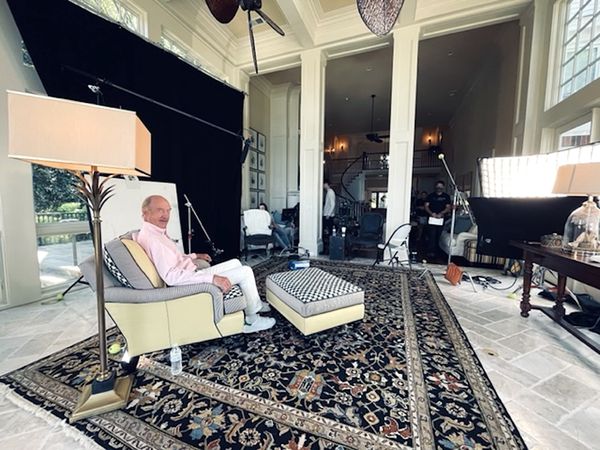 |
| Tennis legend Stan Smith at home on set in Danny Lee’s empowering Who Is Stan Smith? Photo: Danny Lee, SpringHill Company |
Rebecca Halpern, the director of Love, Charlie: The Rise And Fall Of Chef Charlie Trotter and a producer of Who is Stan Smith? (both DOC NYC highlights) set me up with executive producers LeBron James (NBA's all-time top scorer), Maverick Carter, and Jamal Henderson (Uninterrupted - SpringHill Company) to meet director Danny Lee. In Who is Stan Smith? we start out being introduced to the famous adidas sneakers worn by JAY-Z, David Bowie, Barack Obama, Pharrell Williams, Phoebe Philo, Raf Simons, Naomi Campbell, Anna Wintour, Mick Jagger, Madonna, Run-DMC (Darryl McDaniels, Joseph Simmons, Jason Mizell), Beastie Boys (Adam Horovitz, Mike D, Adam Yauch), and John Lennon to name a few.
Donald Dell and John McEnroe (both seen in Rex Miller and Sam Pollard’s Arthur Ashe documentary Citizen Ashe, a 2021 DOC NYC highlight) discuss the tennis legend, Stan’s wife Margie Smith shares with us the family man, brother Ken Smith comments on his early life, and sports journalist Cari Champion on what it takes to be a tennis champion.
The wide-ranging, life- and career-defining documentary tackles the impact of the Pasadena tennis patrons at the start of Stan Smith’s career, watching Arthur Ashe in 1963 on the American Davis Cup tennis team, Stan playing doubles with the “snoring” Bob Lutz, the violent year of 1968, the results of standing up to the International Tennis Association, and Ashe’s widow Jeanne Moutoussamy-Ashe on his activism and their friendship with the Smiths.
During the US State Department tour of Southeast Asia Stan Smith saw the wounded soldiers in Saigon, which was a life changing experience. Margie and Stan became involved in the political movements in South Africa fighting to end apartheid, and we hear about their mentoring South African tennis player and author Mark Mathabane (Kaffir Boy: The True Story of a Black Youth's Coming of Age in Apartheid South Africa, 1987). A phone call from adidas’s Horst Dassler arranging a midnight meeting with Stan Smith and Donald Dell, Smith winning Wimbledon in 1972, becoming the #1 tennis player in the world, and having his name and image on the infamous sneaker, plus the Wimbledon boycott in 1973 are some of the memorable stepping stones in an extraordinary life.
From Hollywood, Danny Lee joined me on Zoom for an in-depth conversation on Who is Stan Smith?
Anne-Katrin Titze: Hi Danny!
Danny Lee: Hey Anne-Katrin!
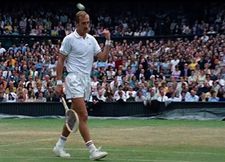 |
| Stan Smith on the tennis court Photo: Danny Lee, SpringHill Company |
AKT: You start your film on Stan Smith with a sneaker collector. We see later on David Bowie and Naomi Campbell and Obama and there is Madonna lifting up her foot to have the shoe signed and there’s Anna Wintour and Phoebe Philo, etc., etc. So my first question is, do you have Stan Smith sneakers?
DL: I do! Definitely. I got a pair, two of them, then I got a third autographed by Stan somewhere around here. Of course, I’ve always worn Stan Smiths, so when the project arose it was pretty much a no-brainer.
AKT: So the shoes were your introduction to him as well?
DL: 100%. I’m not going to age myself here but I didn’t grow up watching Stan Smith play. My introduction and exposure to him was in high school where I would see some very cool looking sneakers. I remember in school it was always the coveted shoe to have.
I thought it was really interesting that most people wanted to either know if he was even a real person, whether he was alive, whether he might be a character on American Dad!, the animation show. Some people thought it was an Adidas designer. But for me, I always knew that he was a tennis player and icon but I got to know him better of course in the course of making the film.
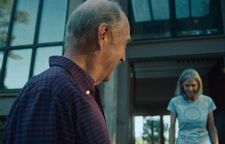 |
| Stan Smith with his wife Margie Smith Photo: Danny Lee, SpringHill Company |
AKT: It’s nice that the interest in a coveted sneaker can unravel the story of a person who is so much more. And also not just a great athlete but as a person. I like all the personal touches, for instance when he talks about the ball boys being chosen for the Davis Cup and that he wasn’t among the chosen ones! These are lovely nuggets. Did you coax them out of him?
DL: It wasn’t that much coaxing. Stan and I developed a very close rapport. As a documentarian you develop that skill, that instinct. I was genuinely curious about him. In selecting what makes it into the film we wanted to humanize Stan Smith, this man who sits on the pantheon of tennis greats and is immortalized in this shoe.
We found out that he was this awkward gangly kid who discovered tennis late in his life. His family [as a young boy] didn’t support him terribly in that pursuit and he essentially found his chosen family through the course of tennis.
AKT: When he is talking about his goals, that’s not his handwriting, or is it?
DL: It is his handwriting! That’s his actual hand and obviously we shot it against the sunlight so there’s a silhouette so you maybe don’t see the wrinkles or hair on his fingers, but that’s his hand, his pen, his handwriting.
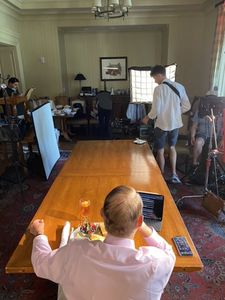 |
| Danny Lee on Donald Dell with food on camera: “I wanted to create this aura of this kingpin at the end of the table …” Photo: Danny Lee, SpringHill Company |
AKT: I was wondering.
DL: I love your attention to detail! That’s amazing.
AKT: His wife is great. There are so many documentaries where the spouses just sit there, frozen, obviously thinking “Oh no, now I have to say something nice about my husband.” Not so here! She comes across as a wonderfully warm woman.
DL: I think you nailed it. Oftentimes you have an iconic figure and don’t really look under the hood of the support that person had. It goes back to our initial Zoom when I met Stan and Margie. She was right next to him and I knew right away she was essentially his rock. She was equally important to the story.
Stan has such a rich story - the shoe, tennis, with his humanitarian efforts, with his relationship with other players, with his friendships. What really stood out was this love story between them. I kept telling the team - the B story is the love story; Margie is so fundamentally important.
I wanted to celebrate the woman who stood by his side, who gave up her own tennis career to keep the family together. In many ways I can relate to that a little bit. My wife, Catalina Vela Lee, she gave up much of her own career pursuits because of our family. I’m not trying to get too personal, but instead of having a nanny raise our children, she’s able to be there. I really appreciate that. So I saw a lot of my own family structure in Stan and Margie’s story.
AKT: She reveals even that in her diary at the time she wrote about the “bad crush” she had on him. Of course another very interesting relationship is with Arthur Ashe, and his widow, who became part of the family, really. There was Rex Miller and Sam Pollard’s Arthur Ashe documentary recently Citizen Ashe and I spoke with Rex as well. It’s good to be reminded thatches tennis greats used their fame to something much larger than a little ball.
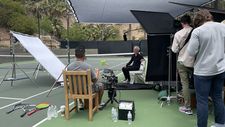 |
| John McEnroe being interviewed Photo: Danny Lee, SpringHill Company |
DL: Absolutely. Arthur came around at the right time, right? In ’68 there was a lot of social unrest and upheaval.
AKT: Also the year of assassinations.
DL: Right. Also with the backdrop of the women’s rights movement, the anti-war movement, obviously civil rights movement, so I think maybe he had the tailwinds behind his back. It was finally time to speak up when he had to keep his mouth shut for so long growing up.
That very much aligns with LeBron James and Maverick Carter’s empowerment brand [UNINTERRUPTED - SpringHill Company] - they are production partners on this. That very much aligns with their mandate, their mission statement of making sure we empower athletes, and that they use their platform to affect some sort of social change. All of it felt very synchronous in the film.
AKT: The power in a name can be used for good and can be used for bad as we see every day. You show an entire sequence about their week in Vietnam. The tour went to Bangkok and then they had them stay for a week in Vietnam! Were you surprised by that aspect?
 |
| Margie and Stan Smith’s family Photo: Danny Lee, SpringHill Company |
DL: Yeah, very much. Stan’s is a very clean story. He didn’t have a lot of tumult in his own personal story. So we were exploring ways to amplify the tension points. And Margie said “Oh, I got all those film reels in the closet” that they had never developed. And once they developed them they had an inkling of an idea of what was on them.
When we saw that they had covered the entire State Department trip all through Asia that coincided with the Davis Cup tour - seeing footage of them playing tennis on an Army base! That’s probably one of my favourite sequences in the film. It’s pure friendship, it’s so earnest and beautiful. You see these tennis players - and tennis is pretty much a singular sport. You have your coach but generally you are alone on the court. Here it shows brotherhood and I love these anecdotes that are just very human. The Vietnam footage was amazing, I couldn’t believe what they had.
AKT: And it’s placing it all in history. It feels like a map when suddenly you realize how certain streets intersect. This is how world politics and personal politics connect. Donald Dell, the agent, I think I realized about three quarters into the film that he always has different food in front of him when you are filming him. He sits at this big table like a king who is having lunch, that is different lunches. Can you explain?
 |
| adidas Stan Smith sneakers on Fifth Avenue, matching Barbour sweater, collection Anne-Katrin Titze Photo: Anne-Katrin Titze |
DL: Yes! I love your eye on this film! To Donald’s defense, this was all my doing. I set up this thing, exactly that. I wanted to create this aura of this kingpin at the end of the table and it was my idea for him to have lunch during it. We had to keep refilling his ice tea, refilling his food. My idea, he’s usually not like that.
AKT: That’s very funny, you succeeded!
DL: I love that is something you called out; that’s amazing.
AKT: Horst Dassler and the whole adidas connection are a ghostly presence. The 12 midnight meeting feels mysterious and slightly seedy. Can you talk a little more about that part?
DL: Yeah, I remember as we were going through all our pre-interviews with Stan we talked about that initial meeting. I just thought that was incredibly funny how straight-laced Stan, who was incredibly Christian and read the Bible daily, is suddenly thrust into the seedy underworld of Parisian nightlife. We wanted to amplify that. Obviously we shot some recreations. There’s a lot of fun moments that actually had to hit the cutting room floor because there was so much story.
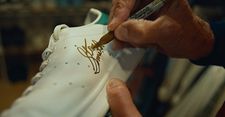 |
| Stan Smith signing a Stan Smith sneaker Photo: Danny Lee, SpringHill Company |
AKT: You just said that Stan Smith is so straight-laced and it seems so non-dramatic because people aren’t hit over the head with guns or anything like that. It makes the film much more interesting. I showed my students a clip from 1969 of Mr. Rogers talking in front of the Senate in order to get funding for PBS. He tells Senator Pastore about his show and that it deals with things the kids are concerned with, such as getting a haircut or “I’m fighting with my brother today.” That’s much more meaningful than the constant battles on all levels we see. And your film has these wonderful quotidian moments.
DL: I love that and appreciate it. Thank you so much for even picking up on that. I never forget the entertainment factor. Everything needs to be purposeful and meaningful but some things just tickle you. A lot of these anecdotes humanize Stan. Even having haemorrhoids and having to sit out a Davis Cup match. Or feeling like the prude of the group. Or being too gangly and awkward to be a ball boy. I think all those things humanize him and that’s what makes a film ultimately endearing.
AKT: The joining of the Wimbledon boycott and how much it cost them, that is a great point about standing up for what you believe in.
 |
| adidas Stan Smith sneaker in Nordstrom on West 57th Street Photo: Anne-Katrin Titze |
DL: Yes, standing up for what you believe in, trying to help your fellow human. At the end of the day, yes, the scoreboard counts, but the legacies that have an enduring impact are when you really meaningfully impact society and culture. That really is the ultimate morale of the tale.
AKT: And you show that in the last act of your film, starting in 1977 and his playing in South Africa. And meeting Mark Mathabane and how big the story becomes. At first you think it’s simply Margie Smith talking to a boy at the tennis court, then how it grows.
DL: I thought it was amazing that it was this chance encounter. Mark had been in essence stalking Stan, he knew he was coming and Arthur. It very much could have been Arthur who had encountered Mark. Mark very much embodies the humanitarian aspect of the film and how Stan did it very much quietly. Mark’s story also provided conflict and tension I think we needed in the film.
Stan reveals that he harbours a little bit of guilt for not being as supportive of Arthur Ashe’s causes while he was still alive. Not that he didn’t support but maybe he wasn’t as present. And I think Mark maybe embodied the ability to reconcile that fact.
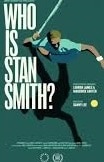 |
| Who Is Stan Smith? poster |
Mark merits his own documentary, he’s so eloquent, he’s a writer. It comes down to how tennis created this bond of humanity between people from opposite ends of the earth. I picked up tennis only recently during the pandemic in the very beginning and I found myself playing people with whom I never would normally hang out. I thought that was a beautiful thing.
AKT: It is. You made some great choices with this film, thank you so much.
DL: Ah, thank you! Nice talking to you, hope to talk again!
AKT: I’m glad that Rebecca Halpern mentioned you when I spoke with her about the Charlie Trotter film.
DL: She’s an amazing filmmaker.






















